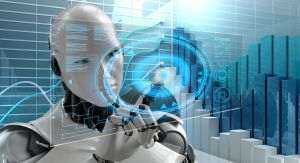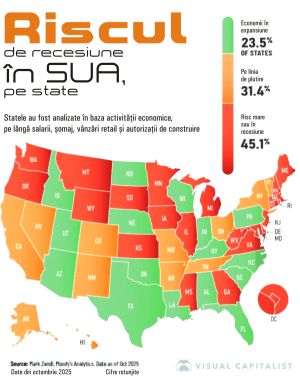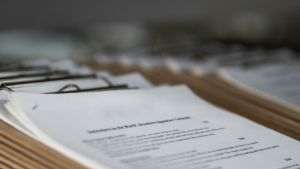• "Markets currently overestimate the inflationary peril", says James Rickards
• According to the economist, in 2008 a dollar produced over 10 dollars worth of goods and services. Today that same dollar barely produces another three
Şapou:
James G. Rickards is an American investment banker, lawyer and economist with 35 years of experience on Wall Street who has held senior positions at Citibank, Long-Term Capital Management and Caxton Associates. His clients include institutional investors, but Rickards has also worked with national agencies in the United States, including the CIA, with which he has worked as a consultant.
Rickards is the author of several books on finance, including three bestsellers on the New York Times list, such as The New Case for Gold (2016), The Death of Money (2014) or Currency Wars (2011). Throughout his career he has published texts in the Financial Times, Evening Standard, New York Times, The Telegraph and the Washington Post. He is currently the editor of the monthly financial newsletter Strategic Intelligence.
He has attended an international conference as guest speaker on March 25, called How the World Will Change in 2021 & the Impact on the Global Economy, Markets and Retirement Funds.
Central banks in developed economies fail to stimulate inflation because the velocity rate of money in the economy has collapsed over the last decade, says James Rickards, American investment banker, who is of the opinion that developed economies have reached the point where indebtedness is a impediment to economic growth. Rickards said on March 11, in an international conference, that real interest rates, those taking into account inflation, must be much lower (negative) than those currently in effect to truly stimulate national lending and economies. Rickards gave a personal example: in the 1980s he took out a mortgage at a very high interest rate of 13%, but the inflation at that time was 15%, inflation that, combined with the tax breaks in New York, made the actual interest rate paid on that loan to be -8%.
James Rickards said: "The real rates should be much lower, -2% or -3 % for the economy to be stimulated. We see the Federal Reserve printing trillions of dollars and the US Congress implementing fiscal packages with a deficit of trillions of dollars, but none of those plans is going to work (in stimulating lending and the economy).
The money that the Fed prints (over 6 trillion dollars in 2008 herein - ed. note) goes to banks, so they buy bonds that banks give back to the Fed in the form of surplus reserves. The money is just sitting there (in the system), the Fed prints it as liabilities and it returns as bond assets and then once again returns to the reserves. So the money is not going out into the economy, it is not being borrowed and spent, which is what you want to happen if you want to move the economy again".
The money printed by the EDF is however being seen in the inflation of financial assets, Rickards shows, who worked 35 years on Wall Street and published more books about finance, such as Currency Wars: The Making of the Next Global Crisis and The Death of Money. With regard to expenses on deficit, the economist shows that in the United States and in many developed countries, it has reached the point where debt is an impediment to economic growth.
"There is the so-called Keynesian Multiplier (fiscal multiplier - ed. note). The point is that you, the government, borrow a dollar, spend a dollar and get more than one dollar in the GDP. Maybe 1 dollar and 20 cents, 1 dollar and 30 cents. There is empirical evidence in that regard. That works, however, under certain conditions: when you're just getting out of a recession or you are in a recession and have low debt and a lot of unused capacity (production). Then yes, if people do not want to spend, the government can do it, with certain results (positive). But there comes a time when the multiplier goes below 1, and the ratio was identified at 90% of GDP, when the debt reaches 90% of GDP. So borrow a dollar, spend a dollar, but you get only 80 cents or 90 cents back to the GDP. You do not get the whole dollar, and something more, all you do is dig an even deeper hole, because you are borrowing a dollar and the GDP grows by less than one dollar, and that makes the debt/GDP ratio even worse. So we are past the point where additional government debt can create GDP or wealth. It even becomes an impediment to economic growth because people look at it and think it can not end any other way than very badly: we will either have inflation, which is just a hidden tax, or taxes will get hiked to pay off the debt. That makes people save more and spend less, exactly the opposite of what the decision makers want. This is the natural human reaction", Rickards explains.
He further says: "Monetary policy isn't working (in stimulating the economy) because you do not have a sufficient velocity of this printed money, and fiscal policy isn't working because the debt ratio in the economy is already too high. Can the Fed print money ? Yes. Can the government spend money that does not have? Yes, but it does not stimulate."
• Rickards: "Tying the dollar to gold is the only way to avoid the erosion of debt"
Rickards shows that for the decision makers, there is just one solution in the current situation, respectively incentivizing inflation to erode debt.
"One thing out of three can happen at these levels.
First, you cannot borrow to get out of this problem because, as I said, when you borrow a dollar, you spend it and get back less, you actually increase your debt ratio, which becomes a problem for growth.
You can grow out of this problem, by increasing the denominator (the GDP), but there is no evidence that that will happen. I can even go through some proposals of the Biden administration which will negatively affect economic growth, tax increases, increasing regulations, etc.
Basically, there are only 3 ways out: the first is defaulting, the second is inflation and the third is higher tax rates. The latter can be removed from the equation because if the problem is that the economy does not grow, taxation will further affect economic growth. There is also no reason for the United States to default.
We can print the money and so can Australia or any other country that borrows in its own currency. Argentina's problem, for example, is that it prints pesos but borrows dollars. That does not work. But if you borrow in your own currency, you can do it. So we won't go into default, raising taxes is not a solution, and the only remaining solution is inflation. The problem is that central banks do not know how to generate inflation. They've been trying for 12 years and have completely failed. (...) All they have to do is tie the value of the dollar to gold (return to the gold standard - ed. note) and that's where inflation will come from. Gold, priced at $ 15,000 or above, raises prices for anything. The world of gold priced at $ 15,000 is the world of 400 dollar oil and the world of $ 10 per liter of fuel at the pump, the world of $ 100 silver or $ 20 copper. Makes all other prices rise. That's what Franklin Delano Roosevelt did in 1933 and Richard Nixon did in 1971. Roosevelt did it intentionally to break the deflationary trend in the Great Depression. Nixon did it accidentally because he did not really know what he was doing, and then he was distracted by Watergate. It took some years to happen, but in both cases the dollar was devalued in relation to gold and inflation was immediately behind. This is the path to escape this chaos. But it probably won't come immediately, rather we will first have deflation before we reach the kind of inflation they are talking about," James Rickards said.
• "The spark that lights inflation is the money velocity", the banker says
Rickards also shows that the US money supply has steadily increased between 2008 and 2020 and then rose vertically, to more than 7 trillion dollars. He states that the printing of money alone does not generate inflation, it takes a spark.
"When they see that, people say "Well, look, there's your inflation, the Fed has printed 4 trillion dollars and we will have inflation." No, printing money does not generate inflation. Most people think like that, so did Milton Friedman, that's what everybody has been taught. But it is incorrect. Inflation is caused by the velocity of money. Money is like dry wood, it won't catch fire on its own, it needs a spark. Money velocity is that spark. In short, if I go out to dinner in town, and give the waitress a dollar, and she takes the cab home and she tips the driver, who buys gasoline with that money, my dollar has a velocity of three. But if I stay home and watch TV, my money has a velocity of zero, because I did not spend it. If you do not have velocity, you do not have an economy. And velocity is collapsing. This is how monetary policy can be understood. The money supply is seeing a massive increase, but the velocity has also been crashing since 2008. In 2020 the crash was even steeper. The velocity collapsed from nearly 11 (in 2008) to nearly 3 (in 2020). This means that in 2008 a dollar produced over $ 10 in goods and services. Today, the same dollar only produces $ 3 in goods and services, and the velocity movement continues to collapse. It is something the Fed cannot control, it is a phenomenon of behavioral psychology made worse by the pandemic,"says James Rickards.
• "The savings rate in the US has surpassed 30%, at the peak of the pandemic"
Rickards also further says that the savings rate in the US has increased to over 30%, at the peak of the pandemic.
"Interest rates rise based on inflationary expectations, and I want to emphasize the word, «expectations» - we have this fiscal plan 1.9 trillion dollars in the US which will grant checks of 1,400 dollars to almost everyone. The expectations are that people will run fast and spend their money, which will boost the GDP above its potential and we will have inflation. And that is why the interest rates are rising. But no, that's not what will happen. Yes, we will give the checks, but the evidence is quite solid that people aren't going to spend that money. In fact they're saving it. The savings rate in the US has a rather stable pace ranging from 5% to 8%. There is some volatility, but is somewhat constant between 5 and 8 percent. In the beginning of the pandemic, it rose to nearly 35% and it fell, but not to the historic median, but somewhere around 13%, and in the most recent report it rose to 14%.
Now, in the US, we have very low interest, which means you can grant money to people, but they do not spend it. They either put it in the bank or they pay off their debts. Again, spreading money around not do any good if it is not spent, and people aren't doing that now. Some people have lost their jobs, they're not taking their friends out to dinner but are instead they are putting their money in the bank or paying off their debts. Even if someone hasn't lost their job, they could be worried that it might happen and as a result they're putting their money in the bank «for rainy days."
"At this time there is no inflation. Interest rates grow on the basis of inflation expectations and I want to emphasize the word," expectations "- we have this 1.9 trillion dollars in the US through which checks of $ 1,400 will be awarded All citizens. Expectations are for people to flee fast and spend the money, which will boost GDP over potential and we will have inflation. Because of this, they grow interest. But no, it will not happen. Yes, we will give the checks, But the evidence is quite solid that people will not spend the money. Actually, I save them. The US savings rate has a fairly stable rhythm between 5% and 8% (see chart saving rate in the USA - No). There is some volatility, but it goes quite steadily between 5 and 8 percent. In the onset of the pandemic, it climbed to almost 35% and lowered, but not in historical media, but somewhere at 13% and in the latest report climbed to 14%. Now, in the US, we have very low interest, which means that you can pay money to people, but they do not spend it. Or I put them in the bank, or pay their debts. Again, divide money does not do any good if they are not spent, and people do not do that now. Some people have lost their jobs, they do not get their dinner friends but put the money in the bank or pay their debts. Even if they did not lose your job, you can worry that it can happen and as a result of the bank «for black days."
Rickards states that the 10-year nominal interest in the US is close to 1.6%, while inflation is somewhere around the same, which leads to a real rate of about 0%. When inflation data below expectations will be published, the interest rates will return to the lower levels of the recent months, Rickards said.
On January 11, the US Labor Department announced that the inflation rate increased at a monthly pace of 0.4% in February, up from a monthly pace of 0.3% in January. That development, although it was the fastest increase in consumer prices since July and the new consecutive increase, was in line with the economists' expectations, which has assuaged some of the inflationary fears in financial markets.
The annual rate of US inflation accelerated up to 1.7% in February, the highest level in the last 12 months. Basic inflation (Core), the one that the Fed, the United States Central Bank, takes into account in making the money policy decisions, came under the estimation of the market, at an Y/Y increase of 1.3% in February, compared to the estimated 1.4%.
The price index that excludes food and energy climbed by 0.1% in February over January, food prices rose 0.2% in the US in February, overall energy prices increased by 3.9% - mainly on the back of higher crude prices which led to fuel price increases -, airplane ticket prices fell 5.1%, the clothing index fell at a monthly rate of 0.7%, after an increase of 2.2% in January, insurance policies rose 0.7%, and rent fell 0.1% to the lowest level since August 2011.
Mihai Gongoroi





























































